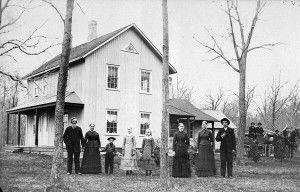By James Stitt, originally published in the Waconia Sun Patriot, May 11, 2016
The Carver County Historical Society took another step towards restoration of the Andrew Peterson Farm in Laketown Township, as the county board approved a conditional use permit for the development and use of the property.
The historical society plans to host educational activities, school programs, tours, and occasional events, one the infrastructure is in place.
The years have not been kind to the international treasure, as storms have wreaked havoc on the buildings. In 2010, a pair of storms battled the North Barn, taking down much of the east wall. The barn has since been stabilized, but a new roof is needed in addition to several other repairs. The historical society has acquired six grants in relation to the farm, and are planning to officially open the area to the public next year. As of now, interested parties can reach out to the historical society for a self-guided tour.
The Carver County Historical Society has planned a dedication to the farm on July 25, where several local representitives will be in attendance. A symbolic tree will be planted at the ceremony, and University of Minnesota students will demonstrate a smartphone app that creates a virtual reality tour of the farm.
“You will actually see what it was like during Andrew Peterson’s time,” said Wendy Petersen Biorn, executive director of the Carver County Historical Society.
The conditional use permit and the dedication is just one of many steps to be taken toward opening the Andrew Peterson farm.
“This is important, we’ve got people right now in Sweden very excited and they’re coming here and spending their money in Carver County which is just a wonderful thing,” commisioner Randy Maluchnik said. “I’m just really for that, so this will be an international tourist destination and rightfully so. And I’m excited about this project moving forward.”
Andrew Peterson
Andrew Peterson was born Anders Petterson on Oct. 20, 1818, on a farm in Sjoarp, Vastra Ryd, Ostergotland, Sweden. His family had financial ties to the church, so he and his brother received a better education than many farmers of the time. He had interests in music, and experimental agricultural and farm techniques.
In 1850, at 32 years old, Andrew Peterson immigrated to the United States, arriving in Boston on July 2. During his voyage, Peterson began keeping a daily journal. He would continue writing for the next 48 years, until 2 days before his death. Most of the early journals were unfortunately later lost. From Boston, he traveled west to Peru, IA, and then on to a settlement called New Sweden, near Burlington, IA. While in Iowa, Peterson “Americanized” his name, from Anders Petterson to Andrew Peterson.
In 1853, wanting to own land of his own rather than working for others, Peterson visited Minnesota where he filed a claim for a farm. 2 years later, on May 4, 1855, Peterson left for Minnesota permanently with his sister and her family. He settled on his claim close to a community called Scandia, near Waconia. He began an orchard on his land, as well as farming more traditional crops. The farm was his by Dec. 6, 1856. During these years, Peterson was a founder of the Scandia Baptist Church. Meetings were held in his home. A church building was erected not long after.
Peterson visited nearby King Oscar’s settlement, near the 21st century town of East Union, to buy more trees and grafts for his orchard. While there, he met a woman named Elsa. They married in 1858 when he was 40 and she was 23. They had nine children: Ida, George, John, Charles (Carl), Frank, Emma, Anna, Josephine and Oscar. He continued his daily diary, recording trips to town, work on the farm, visits with neighbors, and in 1862, his thoughts on the U.S.-Dakota conflict. His orchard was blossoming, with the farm producing apples, pears, plums, grapes, and cherries.
In 1874, Peterson joined the Patrons of Husbandry, a national fellowship of farmers. He sent apple grafts to growers as far away as Iowa. His experimental work was recognized at the Jan. 1888 annual meeting of the Minnesota Horticultural Society. He received an honorary life membership, by unanimous vote.
At its height, his orchard produced over 200 varieties of apples. Peterson hosted tours to leading experts in the field from nearby states and as far away as Ottawa, Canada. Later, his orchard became one of 15 experimental fruit breeding research stations in Minnesota, run by the Minnesota Horticultural Society. His farm was located 6 miles from what would become the University of Minnesota Landscape Arboretum and Horticultural Research Center.
Peterson died on March 31, 1898. His wife Elsa Peterson ran the farm with her children until her death March 8, 1922. As their children died with no heirs, his last daughter Emma gave the farm to Sarah Peterson, a neighbor who had cared for Emma in her old age. The farm then passed into the hands of the Holasek family, who renamed it Rock Isle Farm.
The Andrew Peterson farmstead was placed on the National Register of Historic Places in 1978. His children donated Peterson’s diaries to the Minnesota Historical Society in the 1930s. Swedish novelist Wilhelm Moberg discovered them while visiting Minnesota for research in the 1940s. He used the journals as the basis of his four novels: The Emigrants, Unto a Good Land, the Settlers, and the Last Letter Home. A musical called Andrew Peterson: The Genuine Pioneer Story had great success in Sweden in 2012. In the twenty-first century, Carver County is sister counties with Ydre, Sweden, Peterson’s home county. The Carver County Historical Society restored the granary on the farmstead in 2006 with help from Swedish carpenters, and began restoration on the north barn in 2010.
Turning Point: In 1850, Andrew Peterson journeyed to America and began daily journals that would provide a unique glimpse into the life of a Swedish immigrant.
